Mary Anne Yarde's Blog: The Coffee Pot Book Club , page 100
March 8, 2020
Join me in Conversation with #HistoricalFiction author, John Anthony Mille #Mystery @authorjamiller

A conversation with Historical Fiction author, John Anthony Miller
Please give a warm Coffee Pot welcome to John Anthony Miller.
MA: Welcome to The Coffee Pot Book Club, is wonderful that you could stop by and chat with us today. Before we begin, could you tell my readers a little about yourself?
 JM: Hi Mary Anne, thanks for having me. My name is John Anthony Miller, and I live in southern New Jersey in the U.S., very close to the city of Philadelphia. I’ve been writing professionally for about six years, and Sinner, Saint, or Serpent is my seventh novel.
JM: Hi Mary Anne, thanks for having me. My name is John Anthony Miller, and I live in southern New Jersey in the U.S., very close to the city of Philadelphia. I’ve been writing professionally for about six years, and Sinner, Saint, or Serpent is my seventh novel.MA: I have read Sinner, Saint, or Serpent, and it is brilliant. What was the inspiration behind it?
JM: Five of my prior books are thrillers, with intense plots, and the sixth, a psychological murder mystery, is also very intense. For Sinner, Saint, or Serpent I wanted to write a mystery, but focus more on an interesting cast of characters rather than a fast-paced thriller. I decided on a Jazz-age murder set in New Orleans. The crime is investigated by two reporters, Justice Harper, known for his fairness, and Remy Morel, his sassy counterpart, and they investigate three suspects – all prominent women in New Orleans society. The sinner, Blaze Barbeau, is a real estate magnate with a checkered past, the saint, Lucinda Boyd, lost her family business to the victim, and the serpent is a spooky voodoo queen named Belladonna Dede. I enjoyed writing it. It was fun.
MA: How did you come up with your setting, and your characters?
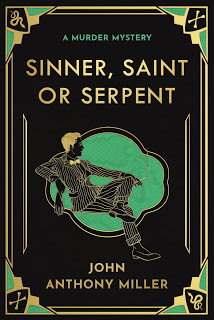 JM: New Orleans is one of my favorite cities, a place I’ve visited six times. It’s famous for Mardi Gras and Bourbon Street, but also has a rich history, fantastic food, and great music – jazz, blues, and zydeco. For the book, I wanted the setting to also be a character, rivaling any of the people – and I knew I could do that with New Orleans.For the characters, I invented people based on what I had seen during my New Orleans visits, like a voodoo queen and a jazz singer. One of my favorite characters is Remy Morel, who is a sassy reporter. During the initial draft, she was a minor character, barely mentioned. But as I continued working on the book, she couldn’t keep her mouth shut and, by the time I finished, she was my favorite.
JM: New Orleans is one of my favorite cities, a place I’ve visited six times. It’s famous for Mardi Gras and Bourbon Street, but also has a rich history, fantastic food, and great music – jazz, blues, and zydeco. For the book, I wanted the setting to also be a character, rivaling any of the people – and I knew I could do that with New Orleans.For the characters, I invented people based on what I had seen during my New Orleans visits, like a voodoo queen and a jazz singer. One of my favorite characters is Remy Morel, who is a sassy reporter. During the initial draft, she was a minor character, barely mentioned. But as I continued working on the book, she couldn’t keep her mouth shut and, by the time I finished, she was my favorite.MA: There are many books in the mystery genre. Can you tell us three things that set your novel apart?
JM: I think what first sets the book apart from other mysteries is the plot. Although there are three primary suspects, there are also several others, and I think readers will be kept in suspense until the very end trying to determine who the killer is. Second, I made the city of New Orleans as popular as any of the characters, using the rich cultural history of the French Quarter as a backdrop. And third, the cast of characters are unique – a voodoo queen, a sultry jazz singer, a mouthy reporter, a Mafia gangster – and I hope my readers become invested in how interesting they are.
MA: One last quick question. What are you currently working on?
JM: My latest effort, which is currently with my literary agent, is called The Drop. It’s set in Havana, Cuba in 1958, and it’s about Cuban revolutionaries who kidnap a rich American businessman and demand the ransom from his wife. There’s just one problem they hadn’t considered. His wife doesn’t want him back.
MA: The sounds fabulous, I can’t wait to read it! Thank you so much for dropping by today.If you would like to know more about John’s fabulous book then you know what to do SCROLL DOWN!
Sinner, Saint or SerpentBy John Anthony Miller
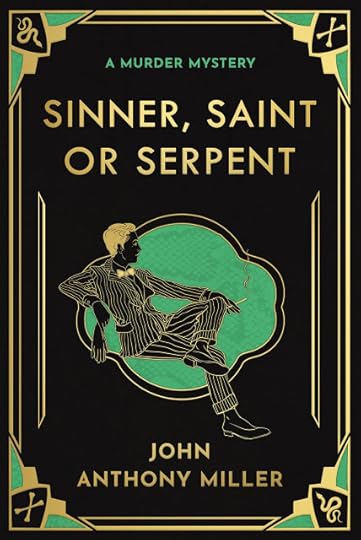
New Orleans, 1926When a leading businessman is found murdered, investigative reporters Justice Harper, known for his fairness, and Remy Morel, his sassy counterpart, are determined to find the killer. There are three suspects, all prominent women in New Orleans society. The sinner is Blaze Barbeau, a real estate magnate with a checkered past. The saint is Lucinda Boyd, who lost her family business to the victim. And the serpent is a spooky voodoo queen named Belladonna Dede.
Excerpt
New Orleans, LouisianaMay 18, 1926 at 7:37 p.m.August Chevalier sat in the parlor of his Royal Street mansion, eyes wide open, a bullet hole in the center of his forehead with a line of blood trailing down the bridge of his nose. He seemed surprised by death’s arrival, or by whoever delivered it, as if meeting his maker had been the farthest thing from his mind at the time.I studied the body from the foyer, leaning against the white molding of the arched entrance, watching the investigation. The corpse sat on a Victorian couch, lavender with lion’s paws feet, a book lying askew beside it. The Prince, by Machiavelli, was a political discourse that supposedly gave good advice for handling enemies to business folks like Chevalier. He should have read it just a little bit sooner. There was an Art Deco table in front of the couch with a glass top and floral wrought iron frame that matched the fence that circled the property. Chevalier’s left leg was stretched out beneath it, a nick on the sole of his Italian leather shoe. Like most rich folks, he wore expensive clothes – a silk blue shirt and darker slacks with barely a wrinkle in them. Even though I had no right to be at the crime scene, I was there just the same. So I just kept looking around the room, scribbling notes on a pad I always carried with me. There was a small leather bag on the floor near the leg of the couch, just beside the body. The string keeping it closed had come undone, and there was a trail of gray powder, a few streaks of vermillion and chunks of something that looked like bones or small animal parts scattered across the Oriental carpet. I knew it was a gris-gris bag, a voodoo charm used to ward off evil or bring good luck – or any number of things that the creator might make for the purchaser. They were popular in New Orleans, especially among the superstitious. And even those that weren’t.A grandfather’s clock stood against the far wall, a leather chair beside it, while a mahogany desk sat just under the side window. It was flanked by two cypress bookshelves, the spines of decorative leather volumes visible as you entered the room. A few papers were arranged real neat on the desktop, with a torn envelope and a folded letter that was a bit crumpled tossed near one edge. It looked recently opened, read and discarded, the contents perhaps not to the liking of the addressee. The writing on the envelope, visible from my location whereas the letter itself was not, showed fine penmanship, a swirling cursive with a flair for the dramatic, sex of the originator unknown. I leaned toward female. Most men I knew, including myself, were just not that neat.
Pick up your copy ofSinner, Saint or Serpent
Amazon UK • Amazon US

John Anthony Miller
 John Anthony Miller was born in Philadelphia, Pennsylvania to a father of English ancestry and a second-generation Italian mother. Motivated by a life-long love of travel and history, he normally sets his novels in exotic locations during eras of global conflict. Characters must cope and combat, overcoming their own weaknesses as well as the external influences spawned by tumultuous times. He’s the author of the historical thrillers, To Parts Unknown, In Satan’s Shadow, When Darkness Comes, All the King's Soldiers, and For Those Who Dare, as well as the historical mystery, Honour the Dead. His latest novel, Sinner, Saint or Serpent, is a jazz age murder mystery set in New Orleans. He lives in southern New Jersey with his family.Connect with John: Website • Facebook • Twitter.
John Anthony Miller was born in Philadelphia, Pennsylvania to a father of English ancestry and a second-generation Italian mother. Motivated by a life-long love of travel and history, he normally sets his novels in exotic locations during eras of global conflict. Characters must cope and combat, overcoming their own weaknesses as well as the external influences spawned by tumultuous times. He’s the author of the historical thrillers, To Parts Unknown, In Satan’s Shadow, When Darkness Comes, All the King's Soldiers, and For Those Who Dare, as well as the historical mystery, Honour the Dead. His latest novel, Sinner, Saint or Serpent, is a jazz age murder mystery set in New Orleans. He lives in southern New Jersey with his family.Connect with John: Website • Facebook • Twitter.
Published on March 08, 2020 21:30
#BookReview — The Definition of Experience (Dan Gamble, Book 1) by Jim Adameit #Thriller @JimAdameit

The Definition of Experience (Dan Gamble, Book 1)By Jim Adameit

One Man’s Stand Against the Corporate Machine
An edgy, racy, action-packed business / financial / technology thriller, about the global industry that manufactures and brings us all our smart phones, laptop computers, cloud servers – and virtually any other electronic products you can think of.
Think this is boring stuff?
In a US$500 billion global market – with careers and that much money at stake?
Think again…
A primer on an industry that most people don’t know exists…A cautionary tale for those people who do…

"Pawns are rarely left on the board at the end of the game..."
Dan Gamble was three short months away before he became fully vested in Stygian Electronics Manufacturing Company. He had sacrificed the last five years of his personal life, travelling all over the world at the company's beck and call, so that he could get to this moment. Dan had suffered the arrogant and ignorant corporate director, Calvin 'Cal' Beaudry's, jibes and the snide remarks, with quiet dignity. So it came as quite the shock when he was formally dismissed.
While Dan was tying up loose ends with Stygian, he noticed a document in his miscellanies file on his computer that he had never seen before. When he opened the document up, he could not believe what he was seeing. Someone was stealing product designs from companies that Stygian worked with. The question was, who?
The Definition of Experience (Dan Gamble, Book 1) by Jim Adameit is an action-packed Financial Thriller, filled to bursting with intrigue, lies, suspense, and drama.
The premise of this book piqued my curiosity, and even though I have no first-hand experience of the contract Electronics Manufacturing Services Industry, I was looking forward to reading and hopefully while reading, learning about it. When I started to read The Definition of Experience I did begin to have a few reservations, for this is an in-depth look into this industry, and I feared I would become lost in the technical jargon and the day to day activities of this vast industry. Thankfully Adameit is a competent tour guide, and he goes to some length to explain what things mean. When a lot of explanation is needed in a book, as this one does, it can sometimes make the narrative somewhat slow and cumbersome, but Adameit has made these explanations part of the story, and therefore it did not affect the pace of this novel at all, nor did it hamper my enjoyment. The short chapters also made this book feel incredibly fast-paced.
The protagonist of this novel, Dan Gamble, is an extremely likeable character. Dan is approaching retirement and knows the industry inside out. However, the rug is pulled out from under Dan when he loses his job. Still, Dan is a very pragmatic man who, although concerned about how employable he is with regards to his advancing years, is determined to secure the future retirement of himself and his wife. When he discovers that there is something sinister going on at Stygian, he becomes this very shrewd detective as he begins to piece things together. After the way he has been treated, he owes no loyalty to his former employer, and he is determined to see justice served. I thought Dan's depiction was fabulous. He is an unlikely hero that you can really get behind and root for. I enjoyed reading about him very much.
It is said that an antagonist can make or break a story, in the case of The Definition of Experience the antagonists, for there are several, made this book unputdownable. The first self-centred and self-important antagonist we meet is Cal Beaudry. Cal is despised at work and feared at home. He is this disgustingly creepy man who has all the charisma of a tormented serpent. Cal really made my skin crawl, and he is the kind of superior that no one wants to be under. Another antagonist that brought out strong emotions is Vincent Spagano. Vince reminded me of a leech. He is almost inseparable from Carson Hayworth "Bud" Styres, the CEO of Stygian. When Vince is not sliming up to Bud, he can be found in strip clubs. He certainly wasn't the nicest of characters.
The real villain in this tale is, however, Bud. He is an especially ruthless man who revels in his position of authority and power. And he gets a kick out of terrorising his subordinates. Adameit does give his readers a glimpse into Bud's life outside of Styres, and although I sympathised with his poor wife, I could not find any sympathy for Bud. He is, in all ways, a predator. Saying that however, his character drove this story forward, and for a villain in a suit, I thought Adameit portrayed him wonderfully.
There are many supporting characters in this book, each with their role to play. Juggling so many characters is always a risk, for sometimes such a considerable cast can confuse a reader. However, Adameit has firm control of his characters and his story, so I did not once find myself confused as to who everyone was and what part in the story they were going to play. Kudos, Mr Adameit.
If you love a good thriller, with an extremely entertaining and gripping plot, then look no further than The Definition of Experience (Dan Gamble Book 1) by Jim Adameit. It is, in all ways, a great success.
I Highly Recommend.
Review by Mary Anne Yarde.The Coffee Pot Book Club.
Pick up your copy ofThe Definition of ExperienceAmazon UK • Amazon US • Smashwords
Jim Adameit
 Jim Adameit is the author of ‘The Definition of Experience’, his debut thriller novel in this series. Jim is a 30+ year seasoned veteran of the Contract Manufacturing / Electronic Manufacturing Services industry, in which he’s held various senior level global positions, including sales & marketing, contract administration, and project management.
Jim Adameit is the author of ‘The Definition of Experience’, his debut thriller novel in this series. Jim is a 30+ year seasoned veteran of the Contract Manufacturing / Electronic Manufacturing Services industry, in which he’s held various senior level global positions, including sales & marketing, contract administration, and project management. Connect with Jim: Website • Facebook • Twitter.
Published on March 08, 2020 21:00
March 6, 2020
#BookReview — Witch of the Wild Beasts by Catherine Stine #HistoricalFantasy #supernatural @crossoverwriter

Witch of the Wild BeastsBy Catherine Stine
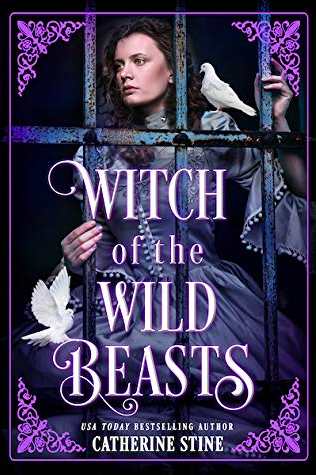
When Evalina is imprisoned for witchcraft, will her supernatural bond with animals be her curse or salvation?
In 1854, Evalina Stowe witnesses the murder of her brother by Dr. Dowdrick, an enraged client at the tailor’s where they work. Desperate to stop him, she rouses a swarm of wasps that sting the doctor while she stabs him with scissors, and then flees. At a subsequent job when birds race to her defence, Evalina is declared a witch and sent to Philadelphia’s Eastern State Penitentiary.
While imprisoned, Evalina is horrified not only to learn that Dr. Dowdrick is still alive, but he’s experimenting on inmates. Determined to get inside his Eclectic Medical School, to expose his nefarious activities, she’s passionate about protecting fellow prisoners, especially Lewin, a child thief who knew her brother, and Birdy, a kind, resilient Welsh man serving time for a worker’s death while blasting granite for the railroad.
Evalina, her friends and her “wild beasts” work against time to unmask Dowdrick’s crimes when she participates with him in a symposium, showcasing Philadelphia’s premium doctors. If they fail, not only will the doctor’s evil deeds continue unchecked but Evalina and her crew will surely be hung.

“They were my heart. My soul. Though they uttered no English, they spoke my language. They never called me Evalina Stowe, my given name, or Eva, my nickname, but most importantly they never called me murderess.”
To murder a man was no small thing but to wrap your hands around a child's neck and squeeze until there was no more breath in his body, that was something different altogether. Evalina Stowe had done everything she could to free her young brother from Dr Horace Dowdrick's evil hold. She had summoned the wasps to sting his face, but still, Dowdrick refused to let go. In desperation, Evalina had stabbed the doctor with a pair of dressmaking scissors. But it was too late. Her brother was dead.
Evalina did not know what to do — she had killed a respectable man. Who would believe that it was in defence of her brother? So, she did the only thing she could do — she fled. However, living as a fugitive was no easy life. It was only a matter of time before she was caught and sent to Cherry Hill Prison. But at least Dowdrick was dead. It was a small comfort.
Kept in solitary confinement at Cherry Hill Prison, Evalina's only comfort was her small wild beasts who squeezed through cracks and crevices to comfort and console her. However, it was not long after her incarceration that Evalina discovered a terrible truth. The man she thought she had killed was not dead. He was here, looking for more victims to use as test subjects for his medical experiments. It was inevitable that Dowdrick would, at some point, call for Evalina. Evalina must gather her courage and her wild beasts if she is to have any chance of defeating him...
From a gruesome murder to a clever plot that exposes a man for what he truly is, Witch of the Wild Beasts by Catherine Stine is the utterly enthralling story of one young woman's fight for justice.
Told with an impressive narrative that captured my attention from the opening paragraph, Witch of the Wild Beasts has an awful lot to recommend it. Stine has penned a story that is both lush, lyrical and next to impossible to put down. I was captivated by this story. I loved every sentence, every word, every syllable. In all ways, it is a Historical Fantasy success.
With a cast of highly appealing characters and a setting that is rich, vibrant and crystalline in the telling, this is the kind of book that gets readers of quality Historical Fantasy very excited about. I adored the characterisation of Evalina Stowe. Evalina suffers greatly in this book. With the murder of her brother, Evalina is all alone in the world — there is no one she can turn to for help. And, unfortunately, being able to communicate with animals is both a blessing and a curse. Although Evalina can bribe the animals and make friends with them, their actions are not controlled by her and many times she finds herself in trouble because of the animals' desperate desire to protect her. They feed on Evalina's emotions. When she is happy, they are calm. When she is fearful, they become protective. I thought Stine's depiction of Evalina was dazzling. This is a heroine whom a reader can really get behind. Evalina is an especially strong young woman who, despite all the suffering, does not become bitter and cynical. Her desire to see justice done is at the forefront of her mind, but she also cares deeply for the friends she makes in prison. She realises that many of the people incarcerated with her should not be in prison. They are good people despite what the authorities might say. Evalina becomes somewhat of a crusader, desperate to make a difference, and if possible, achieve the freedom that her friends deserve. Evalina's sense of right and wrong, her pureness of heart made for a compelling read. There is also a simmering romance throughout this book between Evalina and another inmate which was very sweet.
Bertram "Birdy" Castell was a character that I simply adored. He is a very tender-hearted man who, like many inmates of Cherry Hill Prison, should not be in jail. Yet, with quiet dignity, he is resolved to his sentence, that was until he met Evalina. Although this story is told from Evalina's perspective, we come to know Birdy rather well. Birdy was a character that I enjoyed reading about. His gentle calmness and his tender ways made him a character that was very easy to like.
The antagonist of this tale is Dr Horace Dowdrick. Dowdrick is a man who is corrupted by his desire for recognition and success within the medical profession, and he will do anything to receive the accolade that he thinks he deserves. He is also a ruthless man who is quick to anger. He murdered Evalina's young brother on a whim because the child innocently did something that upset him. He is renowned in the more impoverished community for his violence, and yet he is a respectable man who is trusted and free to go about his business. The social injustice of the time is cleverly weaved into the story, which I thought was very well done. Stine has given her readers a very dark and dangerous antagonist to pit against a young and refreshing heroine.
If you enjoy wonderful escapism fiction, then check out Witch of the Wild Beasts by Catherine Stine. You won't be disappointed. I loved every minute of it.
I Highly Recommend.
Review by Mary Anne Yarde.
The Coffee Pot Book Club.
Pick up your copy ofWitch of the Wild BeastsAmazon UK • Amazon US
Catherine Stine
 Catherine Stine is a USA Today bestselling author of historical fantasy, sci-fi thrillers, paranormal romance and YA fiction. Her novels have earned Indie Notable awards and New York Public Library Best Books for Teens. Catherine's newest historical fantasy, Witch of the Wild Beasts, was a second prize winner in Valley Forge's 2019 RWA Sheila Contest.
Catherine Stine is a USA Today bestselling author of historical fantasy, sci-fi thrillers, paranormal romance and YA fiction. Her novels have earned Indie Notable awards and New York Public Library Best Books for Teens. Catherine's newest historical fantasy, Witch of the Wild Beasts, was a second prize winner in Valley Forge's 2019 RWA Sheila Contest.She loves spending time with her beagle, writing about supernatural creatures, gardening on her deck, and meeting readers at book events. Catherine suspects her love of dark fantasy came from her father reading Edgar Allen Poe to her when she was a child.
Connect with Catherine: Website • Twitter • Instagram • Pinterest • BookBub • Goodreads.
Published on March 06, 2020 20:00
March 5, 2020
#BookReview — Sinner, Saint or Serpent by John Anthony Miller #HistoricalFiction #Mystery @authorjamiller
Published on March 05, 2020 21:00
Join Historical Fiction author, Vivienne Brereton, as she has a brush with Tudor Royalty: Six Wives, Four Mothers. There is also a chance to check out Vivienne's award-winning book — A Phoenix Rising @VivienneBreret1

A BRUSH WITH TUDOR ROYALTYSIX WIVES: FOUR MOTHERSBy Vivienne Brereton

Motherhood was very much on the minds of the six wives of Henry VIII. An awful lot of the time, I would imagine. Every childless month must have brought fresh disappointment, and with it, a feeling of failure. As every ‘barren’ year passed, nagging uncertainty and, in some cases, downright despair must have set in. This was certainly true for the later wives. The first wife, Katherine, a princess of Spain, married to Henry for more than twenty years, remained hopeful for at least ten years that she would finally be able to give him a son and heir but this ebbed away to nothing. Four of them would manage motherhood (Catherine Parr not with the King’s child, but by the man she loved, Thomas Seymour, whom she was initially forced to give up to become Queen). Two of the four wives died as a result of poor hygiene during childbirth: Jane Seymour and Catherine Parr. Two of the six wives died childless: Anne of Cleves, because she was reduced from the status of wife to that of beloved sister. And Catherine Howard because her young life was snatched from her (for a foolhardy affair with her cousin) and with it, the chance of motherhood. In the end, after multiple pregnancies, multiple still births, miscarriages and infant deaths, all Henry’s six queens managed to provide him with were two girls followed by the much anticipated male heir. Amongst all the disappointment and despair, none of them managed a second child. Fatherhood (if not the obsession with it) ended for the unfortunate Henry with wife number three. According to Alison Weir, Henry fathered fifteen children, eight of whom were sons, with seven of the fifteen surviving until adulthood. She attributes the lost eight to poor understanding of pregnancy and childbirth back in the sixteenth century.
* * *
The inspiration for this guest post was a visit I made several years ago with my wonderful sister-in-law, Steph, to the British Library in London where a new exhibition of the Tudors was about to begin. I was due to fly back to France the next day so this was a very exciting finish to my trip. On the way, we must have ‘popped into’ every single charity shop to satisfy Steph’s passion. She was thrilled because Lady Charlotte What’s-Her-Name of Hampstead had been in the last shop the day before and graciously donated half her wardrobe. By the time we arrived at the British Library, of which I was a member, Steph was positively staggering under the weight of this unexpected treasure trove.
Unfortunately, I wasn’t doing so well. It turned out we’d arrived for the Press Preview, not the exhibition which began the next day. ‘PRESS ONLY’, it clearly stated on the poster. Feeling very disappointed, if I’d been alone I know I would have turned for the door. But I was forgetting I was with Steph. Leaving Lady Charlotte’s precious stash with me, she boldly marched up to the desk, explaining that I was an accredited journalist from Nice, France, and asking if it would be possible for me to go in for a “quick peek”. Acknowledging my suddenly acquired credentials with what I hoped was a modest grin, I hurriedly took the press pass from the lady at the desk. “Are you sure you’ll be okay?” I murmured to Steph, feeling both grateful and guilty. “I’ll be absolutely fine,” she answered breezily, shaking out a long red ball gown and a matching silk wrap formerly owned by the generous Lady Charlotte. “I’ll go for a coffee and take a look at all these. You go on in.”
* * *
I needed no second telling and shot up the corridor to the entrance. Imagine my delight when I got in and the first person I saw was a Very Eminent Tudor Historian (several of) whose scholarly books took pride of place on my bookshelves. Elizabeth 1 or Henry VIII themselves might as well have been standing there as far as I was concerned. It was my very own brush with Tudor royalty. Sidling up to the little group of three: the VETH and two clearly awestruck Young Historians, I pretended to be engrossed by a nearby portrait of Katherine of Aragon, my ears closed to anything else, especially their hushed private conversation.
“Do you think her claims of virginity were legitimate?” one of the YHs was asking in a respectful voice.
I couldn’t believe my luck. ‘Was Katherine still a virgin after her marriage to Prince Arthur?’ must be the most asked question in Tudor history. Second only to ‘Did Anne Boleyn really commit adultery?’ and ‘Did Elizabeth die a virgin?’ Lots of interest in the sex lives of these Tudor ladies! Anyway, here I was, standing within touching distance of the very upper reaches of modern Tudor scholarship, breathlessly waiting for the off-record answer from the VETH. Not missing a beat, and with no hesitation, came back the decidedly booming answer. “ABSOLUTELY no doubt whatsoever!” (Only a VETH could be quite so dogmatic and get away with it, I thought). “She never altered her claim. Not even on her deathbed. And no one in those times would lie on their deathbed, risking their immortal souls.” The two YHs were vigorously nodding their heads in unison like those dogs dangling above the dashboard in a car. Hearing this and the VETH’s explanation, I thought about it for a few moments, glancing over at Katherine on the wall. She definitely wasn’t about to give anything away as she stared stonily ahead. Hmm. I wasn’t so convinced. I really wanted to chip in with: “But, on the other hand, she was a mother leaving her precious child behind to a motherless future. She knew an admission of guilt would invalidate her marriage, damn her child for eternity, and rob her of her rightful throne. Isn’t it possible she was willing to risk her immortal soul for that?”
 Henry and Anne
Henry and AnneUnfortunately, I didn’t dare ask my question in case I got packed off to the Tower for impersonating a journalist. What a missed opportunity, though.
* * *
I haven’t changed my opinion about Katherine’s predicament. Amy Licence, in her excellent book, ‘In bed with the Tudors’, discusses Katherine’s claims of virginity: “The question of what the two teenagers did in bed over the course of the next four and a half months would irrevocably determine the course of British history and the development of the Church of England.” The matter of Katherine’s virginity has been picked over at great length, both then and now. For me, it is a somewhat grey area where a young girl and boy of fifteen were put naked into a bed on the understanding that they would do what was expected of them. Katherine claimed that they only shared a bed for seven nights at most…which doesn’t really settle the argument either way. What they actually did, nobody will ever know but they were both highly intelligent and it seems unlikely that they didn’t indulge in at least some kind of attempt at intercourse. Perhaps a fumbling affair that Katherine could later dismiss as non-existent. Who can blame her? The first time, she stood to gain a crown. The second time, in the late 1520s until her death in 1536, she was doing it out of a mother’s love.
There are some poignant moments for the three mothers amongst Henry’s wives. Katherine and her daughter, Mary, ripped apart for the final years of Katherine’s life for not agreeing to Henry’s wishes. Anne at an upstairs window of Greenwich Palace in April, 1536, shortly before her arrest (in my view, merely for flirting with Henry’s friends to make him jealous) and trial for adultery. It was a scene witnessed by many: Anne cradling her small daughter, pleading with Henry. He was clearly angry with her and we can only imagine his cruel words, knowing he had Jane Seymour waiting in the wings. What tragic irony that Anne faced the same unbearable dilemma as Katherine before her death: seeing her daughter reduced to the status of a bastard. Henry’s third queen fared no better than numbers One and Two; how must she have felt when she lay dying in October, 1537, leaving behind a son and heir, knowing this one achievement had cost her everything. In the end, none of Henry’s six wives came out a winner, and for the three of them having a child with the King it led to...death from an extremely rare cancer of the heart; fear, misery and finally death in the Tower of London; premature death after childbirth.
* * *
On that apologetically sombre note, I’d like to thank you, Mary Anne, for inviting me on today. I’d also like to finish by including a short extract from my novel: ‘The House of the Red Duke’. In it, little Valentine de Fleury is listening to her grandmother discussing the royal succession in France with the local Abbot, as well as the vagaries of childbirth. Louis XI, Charles VIII, and Louis XII are the three Valois kings mentioned here, in order of succession. Anne of Brittany was wife to both Charles VIII and Louis XII.
“‘After all,’ said Abbot Anthoine, ‘a possible future king doesn’t marry a woman. He marries a country.’
‘I thought I would die of love. Louis thought he would too. He told me I was the only thing that prevented him from flinging himself off the castle battlements at Blois. Anything to avoid returning to a woman he found so repulsive.’
Abbot Anthoine shook his head. ‘Crookbacked Jeanne with her unfortunate face. Another fine young man forced to marry a girl who was…to be put it kindly… deformed. No wonder he wanted you so badly.’
Valentine’s grandmère gave him a playful punch on the arm. ‘Are you trying to flatter me? I don’t think Louis ever forgave “The Spider King” for forcing his daughter on him, taking malicious glee in the fact that Jeanne would never be able to bear him children.’
‘It was a clever way to end the bloodline of a rival for the throne, you have to admit. Old King Louis certainly deserved his nickname. Like a spider, he lured his enemies into his web and entangled them, with no chance of escape.’
‘Fortunately, he didn’t succeed in destroying myLouis.’
‘Nor did his son manage it either.’
‘I always thought Charles and his sister, Jeanne, resembled a pair of frogs. Don’t you remember how Louis and I used to call Charles “The Frog King”?’ She tutted. ‘My poor Louis. He went to great lengths to divorce Jeanne in order to marry Anne of Brittany but has had no more success in getting a boy on her than Charles did.’
‘We are fortunate to understand the workings of childbearing so much better than we did before. Now we understand that the delivery of a healthy boy, as you might expect, is the product of faith and reason.’ Grandmère Symonne laughed. ‘Whereas the delivery of a girl comes from a defect in the workings of nature.’
‘Or the result of inclement conditions at the time of conception such as a moist south wind. The Queen must pray for a healthy boy next time.’
‘In the meantime, let you and I pray that God sees fit to keep both Louis and my Charles safe in Italy.’
‘Amen.’”
A Phoenix Rising(The House of the Red Duke, #1)By Vivienne Brereton

“If I have anything to do with it, we Howards will live forever.”Thomas Howard
Charismatic head of one of the most powerful Houses in Tudor England. An indomitable old man approaching eighty: soldier, courtier, politician, a ‘phoenix’ rising from the ashes. After a calamitous period of disgrace, the Howards, renowned for their good looks and charm, are once more riding high at the court of Henry VIII.
Set against the backdrop of the extraordinary 1520 ‘Field of Cloth of Gold’, it is a tale of ambition, love, and intrigue, with Thomas at the centre of this intricate tapestryWill Thomas’s bold vow be fulfilled? Danger stalks the corridors of the royal courts of Europe. Uneasy lies the head beneath a crown. Every other ruler – a fickle bedfellow…or sworn enemy.The action takes place in England, Scotland, and France. On either side of the Narrow Sea, four young lives are interwoven, partly unaware of each other, and certainly oblivious to what Dame Fortune has in store for them.“ Nicolas de La Barre laid his lute to one side, hardly bothering to stifle a yawn of boredom. Nevertheless, he couldn’t escape the fact he’d agreed to take on a new wife….”Explosive family secrets are concealed behind the ancient walls of castles in three lands. But… “There are no secrets that time does not reveal.”
The Coffee Pot Book Club★★★★★Highly RecommendedRead the full review HERE!

Pick up your copy of
A Phoenix Rising
AMAZON • BARNES AND NOBLE
• INDIEBOUND
Vivienne Brereton
 Born near historic Winchester in the UK, Vivienne Brereton has been passionate about the Tudors for as long as she can remember. This led to a degree in medieval history at university where she met her future husband. Three sons later and six countries she called home, she finally felt ready to write a novel.Words have always played an important part in Vivienne’s life whether it’s been writing, editing, teaching English to foreigners, or just picking up a good book. In preparation for her novel, she read intensively on the skills needed to write well and did an enormous amount of research which she greatly enjoyed. Having three sons was helpful when she came to write about the characters, Tristan and Nicolas. All those squabbles she had to deal with came in very handy. She also used her husband and sons as guinea pigs for her Tudor cookery attempts with varying degrees of success (abuse).Seeing ‘A Phoenix Rising’ in print for the first time was a moment of great joy for her and she hopes you enjoy reading it as much as she enjoyed writing it.Connect with Vivienne:WEBSITE • TWITTER • GOODREADS.
Born near historic Winchester in the UK, Vivienne Brereton has been passionate about the Tudors for as long as she can remember. This led to a degree in medieval history at university where she met her future husband. Three sons later and six countries she called home, she finally felt ready to write a novel.Words have always played an important part in Vivienne’s life whether it’s been writing, editing, teaching English to foreigners, or just picking up a good book. In preparation for her novel, she read intensively on the skills needed to write well and did an enormous amount of research which she greatly enjoyed. Having three sons was helpful when she came to write about the characters, Tristan and Nicolas. All those squabbles she had to deal with came in very handy. She also used her husband and sons as guinea pigs for her Tudor cookery attempts with varying degrees of success (abuse).Seeing ‘A Phoenix Rising’ in print for the first time was a moment of great joy for her and she hopes you enjoy reading it as much as she enjoyed writing it.Connect with Vivienne:WEBSITE • TWITTER • GOODREADS.
Published on March 05, 2020 20:00
March 4, 2020
#BookReview — Paper Treasures by Lilly Horigan #christianfiction #Romance @LillyHorigan

Paper TreasuresBy Lilly Horigan

Paige McKinnon has finally graduated high school and is ready to embark on the journey she has been planning for years. Alone, she makes her way to Las Vegas where she hopes to locate her mentally ill and homeless mother. A young woman of faith, Paige uses only the prompting of God's Spirit and advice of her aunt to find a place to stay, work, and search for her mother's whereabouts--but will she find love there as well?

"Living in Washington since birth meant there would be some major adjustments to the Las Vegas climate, but she was eager to get started on her new life, a life on her own to answer questions she had waited years to ask."
Paige McKinnon may only be eighteen-years-old, but she had waited her entire life to take this journey. Paige was determined to find her mother — the woman who had lost custody of Paige when she was still a baby. No one liked to talk about Paige's mother. All Paige knew was that her mother, Alex, had severe mental health problems, and she was more than likely living on the streets of Las Vegas.
Seth Redding had not meant to stare when he saw Paige sipping coffee in his favourite cafe, but he felt drawn to her. Finding out that she was to live in the apartment above his mother's shop came as a surprise, but it was a surprise that was very welcomed.
With a new apartment and a new job, Paige begins the next to impossible search for her mother. However, this search is fraught with difficulties, and if it were not for the help of her new friends and Seth, Paige doubted she would have the courage to continue.
From the end of a long journey to the promise of new beginnings, Paper Treasures by Lilly Horigan is a heart-warming and tender Christian romance.
With a sweeping narrative and a visceral understanding of her audience, Horigan has penned a book which is as rich in the romance as it is in story. This book had all the feels — a fabulous plot, a tender love story, and characters that were richly drawn and believable. Paper Treasures is an exemplary example of the Christian romance genre.
Paige is a remarkable heroine who is compelled to find her mother. Paige knows the risks before she embarks on this courageous journey of discovery. Alex is mentally unstable, and Paige has no idea how she will react when she learns that the child that was taken from her, for a good reason, is the adult standing in front of her. At times this journey of discovery left me in tears. I felt for Paige, I really did. Paige feels like there is this void in her life, and she wants to see her mother, even if her mother will want nothing to do with her. Paige is the kind of heroine that a reader can really get behind.
What is there not to like about Seth? Seth is an incredibly caring man who will do anything for anybody. His faith is what holds him steady and grounded, and his feelings for Paige are genuine and sincere. Seth is not the kind of man who breaks hearts — he wants to heal them. I loved Horigan's portrayal of Seth. I thought he was everything a compassionate hero should be.
A character that I simply adored is Seth's mother, Trudy. Trudy's excitement about opening her new shop is infectious. Every time this character made an appearance, I ended up smiling. Trudy's beautiful and loving heart is matched only by her generous nature. This is the kind of woman a son would be proud to call his mother. I thought Horigan's depiction of Trudy was absolutely fabulous.
I have to mention the characterisation of Alex — Paige's mother. Horigan has depicted a very troubled mind in Alex. Through this character, Horigan has demonstrated the terrible effects mental health has, not only on the individual but also the impact of such an illness on family and friends as well. Alex is an emotional time-bomb waiting to go off. She is lost in a world of her own and often strikes out with violence — both in words and actions. Horigan also demonstrates the lack of resources that the authorities face when dealing with such individuals. Alex's depiction was very sobering, but at the same time superbly drawn.
If you are looking for your next Christian Romance, that is impossible to put down, then Paper Treasures by Lilly Horigan is the novel for you. This is the kind of book that I would happily read over and over again.
I Highly Recommend.
Review by Mary Anne Yarde.The Coffee Pot Book Club.
Pick up your copy ofPaper TreasuresAmazon UK • Amazon US
Lilly Horigan
I am a wife to a great guy, a mother of 2 teenage boys, a Navy Veteran, and a business owner. I love to keep busy and fruitful. I am super Type A, very goal-oriented, and a bit of a perfectionist.
I pray you would enjoy my book. It is a work close to my heart and much of my past is woven within the pages. I hope they are pages with purpose that speak to your heart in some amazing way.
Connect with Lilly: Twitter • Facebook • Amazon Author Page.
Published on March 04, 2020 21:00
#CoverReveal — An Ocean of White Wings by Barbara Spencer #HistoricalFantasy @BarbaraSpencerO

An Ocean of White WingsBy Barbara Spencer

Despite the heartbreak of saying goodbye to Rico, Yöst has finally achieved his dream of becoming a fully-fledged cob, able to take to the skies, master of all he surveys. But the price is high and about to get higher. War is waiting on the horizon … and with it the arrival of Kapitein Death.
Once again Yöst will be faced with a choice. To fly with the carinatae, or stay and fight the enemy to keep those he loves safe.
A Word from Barbara Spencer.
In books, the writing of the words, The End, should mean just that. It is done, my story is told. Now I can sit back and rest. And when I wrote those words, at the end of The Year the Swans Came, I meant just that. Somewhere in the back of my mind was the idea that I could leave my audience to complete the story in the way they wanted, much as happened in The French Lieutenant’s Woman. It was the characters who told me something different, nagging at me nightly in my dreams, especially Zande: ‘I’ve got a story to tell, what about it?’
If you read The Year the Swans Came you will recognise Zande, as being the most intriguing of all the actors in this drama. But why, what has happened to make him like this?
And so, the series Children of Zeus took flight, and this three-book series has dominated pretty much every waking hour for the past four years. Predating The Year the Swans Came, the series opens in 1934 in a coastal town on the Bay of Biscay with a massacre.
Question from readers: If the series Children of Zeus is the prequel to The Year the Swans Came, why wasn’t it published first?
Because both my publisher and an author friend said, ‘No way.’ Intrigued?
This is the series introduction and blurb:
‘You must promise never to speak out about your heritage,’ his grandmother warned, ‘because people fear anything different.’‘Fear us!’ Yöst laughed in protest. ‘We are too few to fear.’‘It makes no difference. We are descendants of Zeus, magical creatures …’
Persecuted throughout the centuries for their ability to shape-shift into swans and heavenly beings, three children, Yöst, Zande and a little girl, Tatania, are the sole survivors of the latest onslaught. Unaware of their real nature, Ramon, a gypsy farmer who has fled the conflict in Spain, offers shelter on his farm in return for work. Striking up a close friendship with Rico, the only son in a house full of girls, it is Rico who helps him through the first difficult year. As their relationship strengthens and deepens, Yöst begins to think of staying and making his life there as a farmer … forgetting that as carinatae, his date with destiny is approaching.
The first volume, The Click of a Pebble, came out last autumn. Now, it is the turn of Book 2, An Ocean of White Wings, to be published at the end of February.
Excerpt
When he was young, happiness was his mother and his grandmother, the taste of salt-air and the laughing companionship of friends. Then Death came to call, and ground both their laughter and their lives under its heel.
Scroll down to find out more about The Click of a Pebble.
The Click of a Pebble
By Barbara Spencer

‘You must promise never to speak out about your heritage,’ his grandmother said, her old voice fearful and faint, ‘because people fear anything different.’
‘Fear us!’ Yöst laughed in protest. ‘We are too few to fear.’
‘It makes no difference. You are carinatae, descendants of Zeus, magical creatures …’
Pick up your copy ofThe Click of a Pebble Amazon
Barbara Spencer
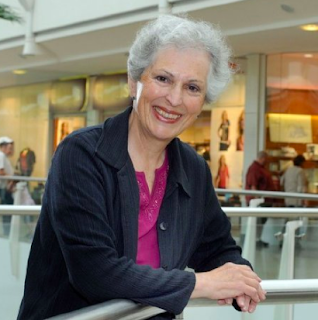
In 1967, Barbara Spencer hi-tailed it to the West Indies to watch cricket, the precursor to a highly colourful career spanning three continents, in which she was caught up in riots, wars, and choosing Miss World. Eventually, she settled in Somerset to bring up a family. In 2010, the publication of Running, her new teenage thriller, has taken Barbara countrywide. Passionate about the importance of books in today's society, Barbara is happiest working with young would-be writers and is frequently invited into schools to talk about creative writing.
Connect with Barbara: Website • Facebook • Twitter.
Published on March 04, 2020 20:00
March 3, 2020
Check out Historical Fiction author, Tony Morgan, fabulous new book — The Pearl of York, Treason and Plot #GunPowderPlot @MorgantheBook

The Pearl of York, Treason and PlotBy Tony Morgan

When Margaret Clitherow is arrested for illegally harbouring Catholic priests, her friends, led by a youthful Guy Fawkes, face a race against time to save her from the gallows. As events unfold, their lives, and our history, change forever.
A Word From Tony Morgan
This is the premise behind The Pearl of York, Treason and Plot, a gripping historical novel written by Tony Morgan, set in the atmospheric streets and buildings of Tudor York.
Margaret later became known as the Pearl. Guy, of course is famous (or infamous) for his role in the Gunpowder Plot. As both were raised in prosperous Protestant families, how did they become Catholic enemies of the state? The novel explores the events which could have persuaded a happily married woman to consider martyrdom and transform a young Yorkshireman into a terrorist.
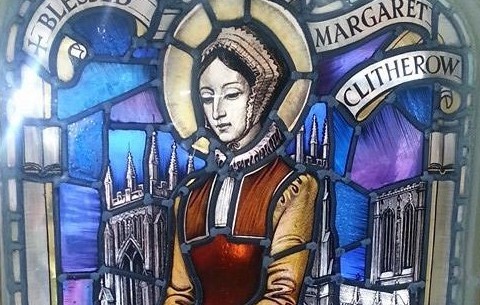
Like all good historical novels, the book is well researched and based upon underlying fact. Guy and Margaret lived within a few hundred yards of each other in the centre of York in the North of England. Guy was born in High Petergate or Stonegate. He went to a private school. His father and grandfather worked for the Ecclesiastical Court of the Church of England. Before marrying and moving to The Shambles, Margaret lived in Davygate. Her natural father was a successful businessman, an alderman and Sheriff of York.Margaret converted to Catholicism in her early adulthood, influenced by a group of older local women. She quickly became part of York’s tightly knit group of recusants, dissenters who refused to attend the official Sunday Protestant church services.
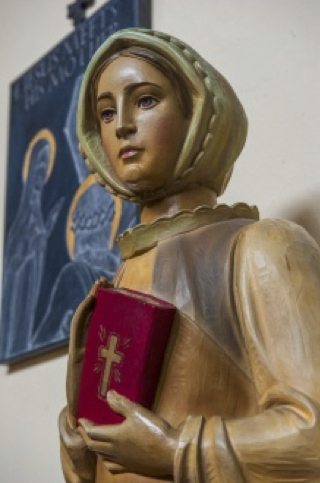
Such public non-conformity came at a cost. Records from the time highlighting Margaret’s crimes and punishments make fascinating reading. Here are a few examples - · 2nd August 1577 “John Clitherow’s wife refuseth service and sermons… committed to York Castle prison”.· 9th February 1578 “Margaret Clitherow appeared with husband and took bond to yield herself prisoner again at the Castle on Tuesday after Low Sunday, ordered not to confer with disobedient persons… The husband to pay 2s for every Sunday and holiday his wife misses church”.· 3rd October 1580 “Margaret, wife of John Clitherow butcher, refuseth to take an oath or conform; committed close prisoner to York Castle”.For almost a decade, Margaret balanced family life with increasingly long spells in prison. In 1581, she was freed under temporary licence to give birth to one of her children. Yet, still she persisted. Two years later, in March 1583, she was sentenced to a further 10 months in jail. Her husband, local butcher John Clitherow, must have loved his wife. For although he remained a Protestant, he paid her fines, and if he wasn’t actively supportive of her errant ways, at least he accepted them.
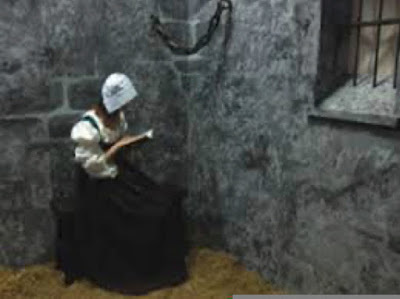 Margaret in prison.Refusal to attend Sunday service was an important crime, but there were worse. Anyone found guilty of harbouring Catholic priests, or hosting Catholic Mass, risked being sent to the gallows.In 1586, Guy Fawkes was in his formative years, completing his education at St Peter’s School. Like all seats of learning, St Peter’s was aligned with the state religion, but beneath the surface lay Catholic undertones. With the previous headmaster languishing in prison for his Catholic leanings, the current incumbent, John Pulleyn, was forced to conceal his own Catholicism, as were many of Guy’s schoolmates. In later years, two joined him in the Gunpowder Plot, whilst others left England to train for the priesthood.
Margaret in prison.Refusal to attend Sunday service was an important crime, but there were worse. Anyone found guilty of harbouring Catholic priests, or hosting Catholic Mass, risked being sent to the gallows.In 1586, Guy Fawkes was in his formative years, completing his education at St Peter’s School. Like all seats of learning, St Peter’s was aligned with the state religion, but beneath the surface lay Catholic undertones. With the previous headmaster languishing in prison for his Catholic leanings, the current incumbent, John Pulleyn, was forced to conceal his own Catholicism, as were many of Guy’s schoolmates. In later years, two joined him in the Gunpowder Plot, whilst others left England to train for the priesthood.  Guy Fawkes.
Guy Fawkes.Guy’s father, a church lawyer, died when Guy was young. When his mother Edith remarried, it was to a Catholic. At this stage of his life, Guy was increasingly immersed in Catholic influences; at home, in school and on the narrow streets and snickets of York. It’s little wonder then, he became a Catholic, himself.

Such religious conversion could have had a major impact on any young man, but would it be enough to transform a Yorkshire schoolboy into becoming a terrorist, willing to kill hundreds of people by bombing of Parliament? Perhaps, something else happened to him, something violent, deadly and shocking.Being near neighbours, Margaret Clitherow and Edith Fawkes would have been well known to each other. If they were friends, Edith may well have attended the secret Catholic Masses Margaret hosted behind the family’s butcher’s shop.On 10th of March 1586, the city authorities lured John Clitherow away from The Shambles. His house and premises were raided by the Sheriff of York. Accused of harbouring Catholic priests, Margaret was arrested and dragged away from her children. If her friends thought she’d quickly be released (after all, her stepfather was the newly elected Lord Mayor of York), they were mistaken. The whirlwind of events which followed were chronicled by a Catholic priest. From his secret refuge, Father John Mush couldn’t have seen everything. He would have needed an accomplice, as his eyes and ears on the streets of York and in the courtroom. The youthful Guy Fawkes would have been perfectly suited.The story behind Margaret Clitherow’s trial is a fascinating one, filled with family tension, politics and intrigue. Here was an ordinary woman, possessing an extraordinary passion for what she believed in. It’s very possible Margaret inspired Guy’s future life.
The Pearl of York, Treason and Plot is available from 1stMarch on Amazon in Kindle and paperback formats. It can also be purchased locally in Yorkshire, for example at one of Tony’s history talks.Amazon UK • AmazonUS
Tony Morgan
 Tony Morgan is a Welsh author and university academic. He lives in North Yorkshire, near to the birthplace of Guy Fawkes and Margaret Clitherow. In addition to writing historical novels, Tony also gives history talks covering the events of the Gunpowder Plot and Margaret Clitherow’s life. To date, all profits from his novels and talks have been donated to good causes. In 2020, Tony’s supporting St Leonard’s Hospice in York. For more details, visit Tony’s website.
Tony Morgan is a Welsh author and university academic. He lives in North Yorkshire, near to the birthplace of Guy Fawkes and Margaret Clitherow. In addition to writing historical novels, Tony also gives history talks covering the events of the Gunpowder Plot and Margaret Clitherow’s life. To date, all profits from his novels and talks have been donated to good causes. In 2020, Tony’s supporting St Leonard’s Hospice in York. For more details, visit Tony’s website.
Published on March 03, 2020 21:00
Join author, Gordon Bickerstaff, as he explores what makes a a strong feminine lead. There is also the chance to check out Gordon’s fabulous book — Die Every Day: For the rest of your life #Thriller #amwriting @GFBickerstaff

How to write a strong feminine leadBy Gordon Bickerstaff
Join Gordon Bickerstaff as he delves into what makes a strong feminine lead.

'Yes, I've had numerous threats—I'd be killed, but they don't bother me. What does affect me is when my family are threatened. That jumps me to a whole new level.'
Interview with Zoe Tampsin about her role as lead character in the Lambeth Group Series by Emily Hopewell
I'm a bit apprehensive. Zoe Tampsin is scary as she marches into this busy London hotel lounge, looking like Scarlet Johansson as The Black Widow, in black boots, black cargo pants, and a very dark blue leather jacket over a black t-shirt. She's taller than I expected. Her hair is short, jet black, she doesn't wear earrings, and I notice her nails are short. As she sits opposite me, and drops her bag at her feet, I'm wondering what weapons she's concealing.
'Nice to meet you. Thank you for your time,' I say, and it's probably obvious to her that I'm intimidated by her presence.
I reach for the tray on the coffee table between us, and pour coffee for her; black with no sugar. I've read the books. We are here to talk about tough, rough, female protagonists, and how they are portrayed in thriller books. I hand her the cup, and say, 'So, the seventh Lambeth Group thriller, Die Every Day, came out last year, and you are still a main character. Have you enjoyed every one?'

She shrugs. 'I haven't been in every one. I joined the series in the second book, Everything to Lose. The series started off as Gavin Shawlens Thrillers, but they rejected Zoe Tampsin Thrillers, so we agreed on Lambeth Group as a compromise.'
I raise an eyebrow. I can imagine how that discussion went. 'I'd like to start by asking about your relationship with the leading male character, Gavin Shawlens. How do you get on with him? It seems fractious most of the time.'
She frowns. 'Gavin may have degrees, and a PhD, and all that jazz, but when you boil it all down; in a crisis, he's as thick as two planks. No offense intended to natural wood.'
Her reply makes me grimace for a moment. 'I see. Some might say you are too bossy with Gavin. Are you?'
After a sip of coffee, she says, 'Is that how it seems? Okay; If I come over as bossy with Gavin, it's because he needs to be bossed in order to get him moving. The story would not develop if I let him move at his pace.'
I flick through my notes for a quote. 'In Everything to Lose, you warn Gavin that if he is insubordinate again, you'll kick his balls so hard, sperm will squirt out of his ears. Is that physically possible?'

She sips her coffee. 'You'll need to ask him that question,' she says, momentarily irritated.
I decide to push on. 'I was wondering what was in your mind when you thought about his sperm. Romance in the air, perhaps?'She shakes her head. 'I was thinking they both have a one in a million chance of becoming a human being.'
We both smile. I recall that scene, and I know what she means. Her eyes send me a signal; she's not here to talk about Shawlens.I start a new page on my notebook. 'Remind me of your role in the Lambeth Group series.'
She put the cup on the table, and sits back in her chair. 'In the 70s, there was a popular TV series called Doomwatch. A group of scientists and spooks, investigate high-end crime and terror threats from the science and technology sector. The Lambeth series takes its inspiration from Doomwatch. So, we are not traditional police crime or private investigators. Shawlens does the science bits. To be fair, he does have other uses. My background is military, and my role is to keep him safe while we discover what the pointy-heads are doing.'
I flick through my notes again. 'I'm interested to know where the thriller industry is going with female characters. Has the time come now for thriller writers to give more attention to female protagonists; is the reading public ready for a female James Bond?'
'Some writers limit female protagonists to girlfriends, sisters, mothers, wives or PA to the male. Their value to the story is limited to who they bed, or pander to. Rarely do such characters explore their own journey. In Lambeth books, my character always has agency, which means she is a plot driver. She deals with the flow of ups and downs, and makes mistakes, some forced; some not. Change is slow, but I believe we will see more female characters given agency in thrillers.'
'Must a main female protagonist always be broken and beautiful?'
With a shake of her head, she says, 'My eternity ring is broken and beautiful, so I don't wear it. Readers want protagonists to face conflict, overcome their fears, or weaknesses, and cope with their faults. My character has her share of problems, including divorce, and a daughter who put herself in peril.'
'Because you weren't there when she needed you most.'
Her brows furrow, and she throws a glance to the side.
'My character is not broken. I'm not perfect, who is? Our readers know where I've come from. They know I have family problems. It means, I have to grow and develop, and if you are involved in a book series, then you must grow. I believe a main female character should be unforgettable, assertive, determined, and captivating in her own way as she fights the fight, and at the same time deals with her own problems. That's my aim.'
'Some writers avoid the woman's back story, and cast her as born strong.'
'It's a mistake. A strong woman is created by the trauma she has come through. As a child, my dad dragged us around countless military bases, so I've weathered a few tornados. My brother and I had to find strength to avoid the inevitable aggravation and intimidation each time we moved to a new base. I became strong; I wasn't born strong.'
I nod my agreement. 'I can't remember which book, but you do recount in one of them that you had a difficult time with your mother. Did she shape your journey?'
'Moving from base to base was a hard life, and on my ninth birthday, I asked my mother if she loved me more than my brother, Michael. Without hesitation, she told me she loved my father more than anything in the world. Certainly put me in my place.'
'I do love your character, but there is a danger you might become stereotyped as a woman with no love, no flaws, strong-minded, continuously attractive, but unaware of your beauty, and at the same time, able to destroy the bad guys. It's not real is it?'
Her expression darkens, and those brows furrow again. I hasten to clarify that in no way shape or form, am I saying she is not attractive. Her expression relaxes, and I sigh inwardly.
'What I mean is; it's good that writers are moving away from predictable male-dependent females, but will they replace them with a type of female sex robot, or pseudo male who is not a real woman, if you know what I mean.'
'It won't happen in this series. I do have feelings. My character has experienced loss and tragedy, and her reactions always reveal a sensitive side. In Everything to Lose, Shawlens discovered that side when he found me weeping over the loss of a comrade who I could have saved.'
I hear emotion in her voice, and I show her a sympathetic expression. 'Your emotional scenes do balance off the rough, tough, stuff. But it must be hard when you're in the firing line, then they target your family.'
'Yes, I've had numerous attempts to kill me off, but they don't bother me. What does grip me is when my family are threatened. That jumps me to a whole new level.'
I smile. 'We've seen that in The Black Fox,and again in Die Every Day.'

I'm curious about her work ethic, and ask, 'Do you regret when an intense mission has a hard impact on your family? Should there be more down time in the stories?'
'I often wonder if there is a parallel universe version of me who is a normal parent. I wonder if she is happy. I'm not sure she would be any happier than me. My daughter, Amy, has had to make great changes, but she knows how important my work is to me, and the country. In the end, I am fighting to keep the country safe, so she can have a good life.'
'If I was an author asking for advice; how do I avoid turning a kick-ass female character into a pseudo male?'
She strokes her chin. 'Focus on where her power comes from, and why. In my case, that is my brother, Michael. Lambeth Group readers will know what I mean. Reveal her good and bad habits, and her failures, but she doesn't have to be broken. I believe my character is compelling because she overcomes challenges and adversity in her job, but in her own life, she is struggling with her problems. Remember, that beyond the action, the fights, and the drama, there are people with defining issues.'
I write furiously to get her advice down. 'To me, you are feminine. In creating a female kick-ass character; is it inevitable that male characteristics will subsume female characteristics? Can the female dimension exist in such a tough character?'
She nods. 'Yes, if a writer can first concentrate on developing the person, then the gender. My character would be less convincing if my first concern was my looks and body shape. Don't get me wrong, I care about my looks and my body; they have priority, after my work is done. I recommend you to read George R.R. Martin. He creates fascinating female characters.'
'His books certainly pass the Bechdel test.'
'What's that?'
'It's a test to reflect on the female characters in a book. To pass the test, a story must have two named female characters who talk to each other about something other than the leading male.'
A smirk breaks over her face. 'Shawlens is our central character, so there is always discussion about what he is doing, or the mess he has created. I do have female friends and colleagues, such as Toni Bornadetti and Karen Turnbell, to name a couple, and we do have conversations about what we are doing, which don't include Shawlens, so I guess, our stories pass the test.'
I'm sniggering as I recall a particular scene. 'They do. I remember the conversation in Tabula Rasa between you and Joss Fricke about her companion, Roger. Like you, every time I hear someone say; Roger that, I drop into a fit of laughter. Did you ever spend time with Roger?

She shows me a tight-lipped smile before she says, 'Loose lips, sink ships.'
We laugh out loud.
'You have become a compelling character in these Lambeth books. What have you brought to the character to make her great?'
'I make it clear what I want. I insist my character is given agency in the plot. I'm not slow to say what scares me, and I reveal the skills I'll use to move the story forward. Most important, when I am acted upon, readers know I give back as good as I get. My character knows her ability, and is confident of what she can do. I want a reader to know me like a close friend. Then, like with any friend, when I'm in trouble, they'll be backing me to do what I need to do.'
I'm curious to find out how she developed her character. 'What books do you read to help you get into the character? Have you read Ian Fleming?'
'No.'
'Have you read Robert Ludlum's Jason Bourneseries?'
'No.'
'What have you read?'
'I have red socks.'
I rush to cover my mouth. Shocked or embarrassed. I don't know.She reaches to pat my wrist. 'Sorry, I saw that coming. Couldn't help myself. I like to read books about the aftermath of an apocalypse. I've just finished Richard Matheson's book, I Am Legend. I've met preppers who are stocked up with water, weapons, food, and all manner of survival tools.'
I notice that the dazzling smile is switching on and off as if to save electricity, so I swiftly ask my final question. 'What does the future hold for your character? I have to say; the end of Die Every Day felt like the end of the series.'
She shrugs. 'Who knows? One thing I've learned about authors is that they all have an innate perversion to convince you one thing is going to happen, then on the turn of a coin, make something totally different happen. More twisted people; I've never met! All I can say is; negotiations have just completed, and my contract has been renewed.'
'Music to my ears. Zoe Tampsin, thank you.' I reach to shake her hand.
While she's been talking, I've seen a side I didn't expect. She's a lot chattier than I expected; entertaining, distant, and friendly all at the same time. But in her eyes, I see a sharpness I'd expect from a determined, mid-life, woman. I'll file her under tricky, unpredictable, intelligent and fearless.
Die Every Day: For the rest of your life(A Lambeth Group Thriller)By Gordon Bickerstaff
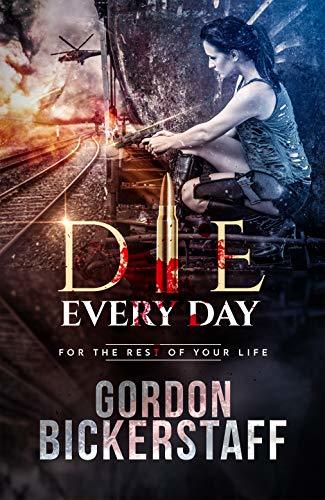
A woman is murdered in a Glasgow city hotel room. Police have everything they need to charge a suspect. Caught at the scene, he confessed, and he's filled with guilt and remorse. With undeniable evidence; the police expect him to plead guilty.Rumours suggest the man will plead not guilty and tell his story. If he faces trial, the truth will cause international outrage and the government will fall.Faceless mandarins in corridors of power are determined he will remain silent.Lambeth Group agent, Zoe Tampsin, is ordered to make him plead guilty. What she discovers will crush her soul and place her next in line to be murdered.Who is pulling the strings? What secrets are they hiding?
Pick up your copy of Die Every Day Amazon
Gordon Bickerstaff
 I was born and brought up in Glasgow, Scotland. I studied biochemistry, and I've worked in several Scottish Universities where I did research on enzymes and taught biochemistry. After thirty years of teaching and research I retired my academic pen and took of a fiction pen. I live in central Scotland with my wife and we enjoy reading, writing, and walking in the hills.The Lambeth Group books are a series of the secret government investigations led by agent Zoe Tampsin. A strong female protagonist with courage, determination, and guile. She is assisted by specialist science consultant, Dr Gavin Shawlens.
I was born and brought up in Glasgow, Scotland. I studied biochemistry, and I've worked in several Scottish Universities where I did research on enzymes and taught biochemistry. After thirty years of teaching and research I retired my academic pen and took of a fiction pen. I live in central Scotland with my wife and we enjoy reading, writing, and walking in the hills.The Lambeth Group books are a series of the secret government investigations led by agent Zoe Tampsin. A strong female protagonist with courage, determination, and guile. She is assisted by specialist science consultant, Dr Gavin Shawlens.Connect with Gordon: Website • Facebook • Twitter • BookBub • Goodreads.
Published on March 03, 2020 20:00
#BookReview — Fateful Decisions by Trevor D'Silva #HistoricalFiction #FamilySaga @TrevorDAuthor

Fateful DecisionsBy Trevor D'Silva
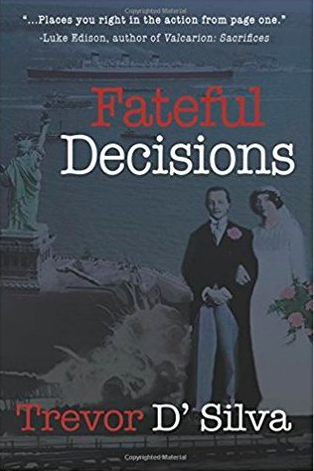
It’s 1915 in the heat of WWI. Two friends heading to England aboard the British ocean liner, RMS Lusitania, meet and fall in love with a charismatic woman. After battling for her affection, Rachel Williams makes her decision, beginning a journey that no one can predict or soon forget. For the next thirty years, Rachel is forced to live with the choice she made, as the dominos fall around her, sequentially.
Is there a sinister force at work? Who can Rachel trust? Will Rachel ultimately regret her decision when she learns how it impacted others?
Set in America and Europe, history and fiction intertwine, commencing with the sinking of Lusitania. Historical events like The Russian Revolution, Prohibition, The Great Depression and World Wars I and II also play important roles in the lives of the characters and the decisions they make to love, betray, forgive, and reconcile.

"I have a feeling that your life will be in turmoil if you get involved with these men."
Rachel Williams should have listened. She should have turned around, walked away and never looked back. But, there was something endlessly fascinating about those Long Island boys.
It was hard to watch your best friend marry the woman you love. Rudolph "Rudy" Holzmann was so sure that Rachel would choose to marry him, but no. Why would she? Fred Johnson had everything — money, position, hotels. However, Rachel would regret her decision. Rudy knew she would. He would make sure she did...
From a chance meeting on the British ocean liner Lusitania, as it left New York Harbour to a wedding that would bring the Johnson family full circle, Fateful Decisions by Trevor D'Silva, is a story that spans 30 years of history and one woman's life.
Having read D'Silva’s second book, I was looking forward to reading his debut. I have to admit at times I struggled with this story. The plot was fabulous, but the writing felt a little underdeveloped. I also felt that D'Silva was overly ambitious with the timeframe of this book. In just over 300 pages, D'Silva covers over 30 years of a very turbulent time in world history The book starts during World War I, we follow the characters as they negotiate the Wall Street Crash of 1929, through to the coronation of King George VI in 1937. We also witness the attack on Pearl Harbour in 1941 and World War II. So much history. D'Silva approaches this in a snapshot sort of way, given the smallest amount of detail while concentrating on the characterisation of the cast. I can understand why D'Silva chose to present his story this way — otherwise, this book would have been epic in proportion. However, I would have liked a little more detail, but that is just a personal preference.
I also struggled to connect with the protagonist, who very quickly, in my opinion, became the antagonist in this novel. To begin with Rachel came across as innocently naïve. But as the story progressed, Rachel allows the wealth that her husband so lovingly bestows on her to go to her head. Rachel becomes selfish and cruel, caring only about her own pleasures, her own interests. There are events in this story that are harrowing, and some terrible things happen to Rachel, but I struggled to sympathise with her. There is one shocking scene when she loses control of her temper and slaps her young daughter so hard that she causes her child to have a nose bleed — that was the moment I could not come back from. Rachel is a cruel woman whom I despised from that moment on. That scene really haunted me throughout the book.
Fred Johnson, the unfortunate man who asked Rachel to marry him, is a character I really liked. He is a very generous man who just wanted his wife to be happy. Fred gives Rachel everything she could possibly desire, but Rachel never loved him, she never really tried to. Rachel married Fred because she needed to marry someone, and he was a good catch. I think this puts a terrible strain on their relationship, and it was, therefore, always doomed to fail. Of course, it is not helped by Rudy, who hides his jealousy of his best friend under a mask of good intentions. Yes, Fred makes mistakes, and yes, he is sorry for them, but I think Rachel was just looking for a way to leave him and his one mistake in a drunken stupor gave her that excuse.
Rudy is a very complex character whom at first, I liked a lot — I was secretly hoping that Rachel would marry him. However, he endures a great deal of prejudice because of his German heritage, and the fact the Rachel rebuked him, causes him to undergo a significant personality change. Rudy becomes someone unrecognisable. I thought D'Silva’s depiction of Rudy was superb. He is such a complex character, and the transformation that occurs within him was wonderfully portrayed.
Another character who I found endlessly fascinating was Barbara (Catherine), Rachel and Fred's daughter. Due to a terrible accident, and a severe case of amnesia, Barbara's life changes forever. Barbara has a rough time of it, especially in the beginning with her emotionally unstable mother, but she grows up to be a very caring young woman.
If you enjoy a family saga then I think you will find this book an exciting addition to your bookshelf.
Review by Mary Anne Yarde.The Coffee Pot Book Club.
Pick up your copy ofFateful DecisionsAmazon UK • Amazon US
Trevor D’Silva
 Trevor D’Silva has a B.S. degree in Mechanical Engineering; M.S. degrees in Engineering Management, and Environmental Engineering; and an Associate degree in Accounting. He has lectured in mechanical engineering and environmental science subjects at various colleges. Fateful Decisions is his first novel, encompassing history and fiction from WW I to the end of WW II. He uses his free time to expand his knowledge in history and reading crime, thrillers, and mystery novels.
Trevor D’Silva has a B.S. degree in Mechanical Engineering; M.S. degrees in Engineering Management, and Environmental Engineering; and an Associate degree in Accounting. He has lectured in mechanical engineering and environmental science subjects at various colleges. Fateful Decisions is his first novel, encompassing history and fiction from WW I to the end of WW II. He uses his free time to expand his knowledge in history and reading crime, thrillers, and mystery novels.Connect with Trevor: Website • Twitter • Goodreads.
Published on March 03, 2020 20:00
The Coffee Pot Book Club
The Coffee Pot Book Club (formally Myths, Legends, Books, and Coffee Pots) was founded in 2015. Our goal was to create a platform that would help Historical Fiction, Historical Romance and Historical
The Coffee Pot Book Club (formally Myths, Legends, Books, and Coffee Pots) was founded in 2015. Our goal was to create a platform that would help Historical Fiction, Historical Romance and Historical Fantasy authors promote their books and find that sometimes elusive audience. The Coffee Pot Book Club soon became the place for readers to meet new authors (both traditionally published and independently) and discover their fabulous books.
...more
...more
- Mary Anne Yarde's profile
- 159 followers



